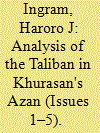|
|
|
Sort Order |
|
|
|
Items / Page
|
|
|
|
|
|
|
| Srl | Item |
| 1 |
ID:
139451


|
|
|
|
|
| Summary/Abstract |
This article analyzes issues 1–5 of the Taliban in Khurasan's Azan magazine. It applies an interpretive framework for analyzing radical narratives, based on a multidisciplinary conceptualization of the radicalization process, to explore how Azan attempts to appeal to its audiences by leveraging ingroup, Other, crisis and solution constructs via value-, crisis-, and dichotomy-reinforcing narratives. Two key findings emerge. First, Azan prioritizes content that empowers its readership toward action with narratives that link ingroup and solution constructs. Second, Azan uses a variety of narrative approaches in order to appeal to a potentially diverse readership at different stages of radicalization.
|
|
|
|
|
|
|
|
|
|
|
|
|
|
|
|
| 2 |
ID:
123344


|
|
|
|
|
| Publication |
2013.
|
| Summary/Abstract |
Based on in-depth interviews with seven Canadian radicals in 2011, this article provides a detailed and nuanced insight into these men's personal journeys into, and in some cases, exit from, the world of radical Islam. Reflecting on their motivation, emotions, and decision-making processes, these men's stories demonstrate that the radicalization experience is anything but straightforward in the sense of there being a single and unambiguous motivation that spurs individuals on. Rather, they reveal that they were drawn to, and remained involved with, the world of extremism for a variety of reasons, not all of which necessarily related to the existence of grievances, real or imagined. Moreover, the relative importance of these drivers appeared to be in a state of flux, depending on an individual's needs or circumstances at any given time. Indeed, the highly idiosyncratic and temporally specific nature of the radicalization process, as demonstrated by these men's accounts, does not bode well for government and law enforcement efforts to anticipate specific cases of radicalization.
|
|
|
|
|
|
|
|
|
|
|
|
|
|
|
|
|
|
|
|
|